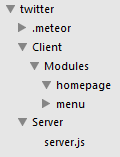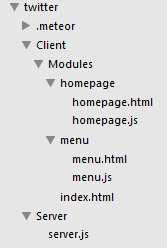Part One
What is MeteorJS?
- Website - https://www.meteor.com
- Docs - http://docs.meteor.com/
- Version - 0.8.0
- Platforms - Win(Not Official), Linux
- WinLink - http://win.meteor.com/
- StackOverFlow tag "Meteor" - 3884(February), 4505(April)
- XAMPP, Denwer
- Download and install http://goo.gl/x47izY
Package System, Meteorite
- Current packages
- bootstrap
- jquery
- backbone
- underscore, less, coffescript, etc
- Atmosphere, Meteorite, will be in box in Meteor version 1.0
Meteor architecture
Project Folders
- Server, Client, Public, Privat, lib
- Variable Scopes
- Meteor Code Gathering Behavior
Autogatherer
- Gathering all CSS files to one (Files are separated during dev)
- Search for HTML files
- Implement separately tags HEAD and BODY
- create javascript Code from TEMPLATE tags. init Template Variables from "name" attribute
- Don`t check Public and Privat folders
- Privat folder for server assets, server libs
- Public folder for client files (images, front-end libs, etc.)


Project from the BOX
just few seconds to start

MeteorJs - reach API for data manipulation
Server - Node.js
DataBase - MongoDB and MiniMongo
MiniMongo - Meteor's client-side Mongo emulator- Document(Object) Based DB
- "High performance, high availability, and easy scalability" (c).
Templater - HandleBars("SpaceBars")
- Just Another Cool Templater
- based on Mustache(Mustache templating language) Syntax http://mustache.github.io/mustache.5.html
- You can Try fast -> http://tryhandlebarsjs.com/
Part Two
Key features
AutoPublish
- Send data to all connected users and ReRender templates
- Establish Connection -> subscribe -> transfer data over DDP
- Websockets. IE8 -> XHR
Automatic Redraw Templates
- publish/subscribe, autopublisher
- Let`s try together http://vocabulary.meteor.com
Simple API - Handlebars
{{variable}} // variable or object property
// Array of Objects
{{#each doc}} //"docname" is a property of each object in "doc" Array
{{docname}}
{{/#each}}
// if else statement
{{#if userLoggedIn}}
{{> indexhtml}}
{{else}}
{{> loginMenu}}
{{/if}}
//--------------------
< body>
{{> menu}} // template name
< /body
{{#each menuitems}}
{{title}}
{{/each}}
Template JS basics
Temlplate.menu.menuitems = function(){
return [
{link:'#1',title:'firstlink'},
{link:'#2',title:'secondlink'}
];
}
Temlplate.menu.currentName = function(){
return Session.get('curname');
}
Temlplate.menu.events = {
'click .node-class' : function() {
// do something
Session.set('curname','Maxim');
}
}
Quick work with DB
// insert data to DB
documents = new Meteor.Collection('documents');
documents.insert({ name:'default', content: 'empty' });
// update entry in DB
documents.update({'_id':currentID}, {$set: {name: 'myDocument'}});
documents.update({'_id':currentID}, {$set: {content: '<h1>Hello!</h1>'}});
//find collection
documents.find({'name':'Maxim'});Part Three
Meteor install, create first APP
-
Download and install Meteor(link at forst slide)
-
Open command panel, go to project folder, Use "meteor create"
-
Creating base folders, files , app structure

Create HTML templates
-
homepage.html in homepage module
-
menu.html in menu module
<template name="homepage">
// write homepage markup
</template>
<template name="menu">
// write menu module html markup
</template>
Add "menu" template html code to "homepage" template
<template name="homepage">
// here homepage index markup
// .....
// now we add MENU template to index template
{{> menu}}
</template>
Create index.html in "Client" folder and add there our "Homepage" html template
< body>
{{> homepage}}
< /body>
Yes, we add our template in BODY tag. We don`t need to add any html base tags like DOCUMENT, head, footer, etc.
We will come back to templates later.
Js files ctructure
-
create homepage.js in "homepage" folder
-
create menu.js in "menu" folder
-
create server.js in "Server" folder
Look at the picture and let`s Go to the "server"

Meteor API and MongoDB API basic
Meteor.startup()
Meteor.methods()
-
Meteor.Collection
collection.insert
collection.update
collection.find
collection.findOne
Meteor.Session
Open server.js file
Meteor.startup(function (){
documents = new Meteor.Collection('documents');
var fs = Npm.require('fs');
//init Meteor methods here
Meteor.methods({
delAllData:function () {
//here we remove all data from documents collection
documents.remove({});
},
insertNewDoc:function(docName, clientId, websiteID){
// here we add new enrty to DB
documents.insert({
'docName':docName,
'clientId': clientId,
'websiteId': websiteID,
'docText':'document is empty'
});
}
})
});Open menu.js file
menuItems = new Meteor.Collection('menuItems')
Template.menu.items = function() {
return menuItems.find({});
}
Template.menu.events = {
'click a' : function(e) {
// do something on click
},
'mouseenter a' : function(e) {
//do something
}
}Open menu.html file
<template name="menu">
{{#each items}}
<a href="{{link}}" target="_blank">{{title}}
{{/each}}
</template>Now each link have Binded "click and mouseenter" events. And we will se on page all links from DB Collection
**Meteor Account Managment**
- faceBook package
- loginPassword basic package
- gitHub Package
**Deploy/Delete Application**
- meteor deploy myapp.meteor.com (remember http://vocabulary.meteor.com/)
- With settings -> meteor deploy myapp.meteor.com --settings ---
****delete app****
- meteor deploy myapp.meteor.com --delete
**test examples:**
- http://cmstest.meteor.com/ - user:admin, pass:maxim
THE END
Prepared by Maxim Shturmin

Meteor Js 0.8.0 Presentation
By maximshturmin
Meteor Js 0.8.0 Presentation
- 1,173